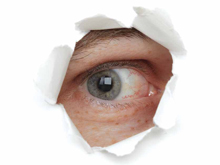Health Topics
-
Healthy Living
-
|
|
March 2011
|
| Eye for Beauty |
| Dr. Ayyappan Thangavel |
| |
 |
Beauty, they say, lies in the eyes of the beholder. But baggy eyelids do not in any way suggest that your eyes have been seeing a lot of it. Blepharoplasty, thankfully, can make you look better Anyone with drooping eyelids and visible folds that create a tired look can look up a surgery for baggy eyelids. More so if they are in the 35 to 60 years age bracket. If you have inherited baggy eyelids you can consider a surgery at a younger age. |
Most patients will enjoy a fresher look after the surgery called blepharoplasty.
The doctor will examine your eyelids for a loss of deeper soft tissue, skin laxity and assess tone of the underlying muscles. Then, the different options available and the risks and limitations of each will be discussed. You will then need to decide whether to do all four eyelids or just the upper or lower lids separately. The new, refreshed look lasts for many years. For most patients, a blepharoplasty yields permanent results.
Unsuitable Conditions
Patients having dry eye, detached retina, glaucoma etc. should consult their ophthalmologist prior to surgery. Be sure to let your doctor if you suffer from any of the following conditions, as they affect surgery:
- Hypothyroidism.
- Graves disease.
- Cardiovascular disease.
- High blood pressure.
- Diabetes.
Preparing for Surgery
Stop smoking well in advance of surgery, because it decreases blood flow to the skin and affects the healing process. You would be advised to avoid certain medications like Aspirin, which can increase bleeding prior to surgery. Enjoying a healthy sleep, food and exercise regime before and after surgery will result in optimum results!
Bagging the Surgery
Blepharoplasty is performed as a day case under general anaesthesia, which will make you sleep through the entire operation and not be aware of the procedure. The procedure lasts an hour or two. In a typical procedure: Psychological preparation, education, massage or water therapy in a tub or shower could help.
- Incisions are made following the natural lines of your eyelid creases for your upper lids, and just below the lashes in the lower lids.
- The incisions may sometimes be extended into the crow's feet or laugh lines at the outer comers of your eyes.
- Then the skin is separated from the underlying fatty tissue and muscle, excess fat is removed or re-spread.
- Sagging skin and muscle is then trimmed.
- The incisions are then closed with very fine sutures.
If you have only a pocket of fat beneath your lower eyelids but no skin or muscle laxity then trans conjunctival blepharoplasty is a choice. In this procedure, the incision is made inside the lower eyelid, leaving no visible scar. It is usually performed on younger patients with thicker, more elastic skin.
- After surgery, your eyes will be covered with ointment and surgical tapes to provide support and comfort.
- Your eyelids may feel tight and sore as the anaesthesia wears off, but this discomfort can be controlled with pain medication.
- Keep your head elevated for several days, and use cold compresses to reduce swelling and bruising.
- You will be shown how to clean your eyes, which may be gummy for a week or so. Eye drops are recommended since your eyelids may feel dry, burn or itch.
- For the first few weeks you may also experience excessive tearing, sensitivity to light.
- The stitches will be removed in between seven to 10 days after surgery.
- Once they are out, the swelling and bruising around your eyes will gradually subside, and you will start to look and feel much better.
What Can Go Wrong?
When eyelid surgery is performed by a qualified plastic surgeon, complications are infrequent. Nevertheless, there is always a possibility of complications, including infection, bleeding or a reaction to the anaesthesia. You can reduce your risks by closely following instructions both before and after. surgery. The minor complications that occasionally follow blepharoplasty include:
- Double or blurred vision for a few days
- Temporary swelling at the corner of the eyelids
- Persistent discolouration (bruising) and a slight asymmetry in healing or scarring.
- Tiny whiteheads may appear after your stitches are taken out, but they can be removed easily with a very fine needle.
- Ectropion (where the lower eyelid turns outwards) may result if more skin than necessary is excised. However, this is correctable by surgery.
- Blindness, it needs to be said, is a dreaded complication, although extremely rare.
|
 |
Dr.Ayyappan Thangavel is Sr. Consultant Cosmetic & Plastic Surgery at Apollo Hospitals, Ahmedabad |
|
|